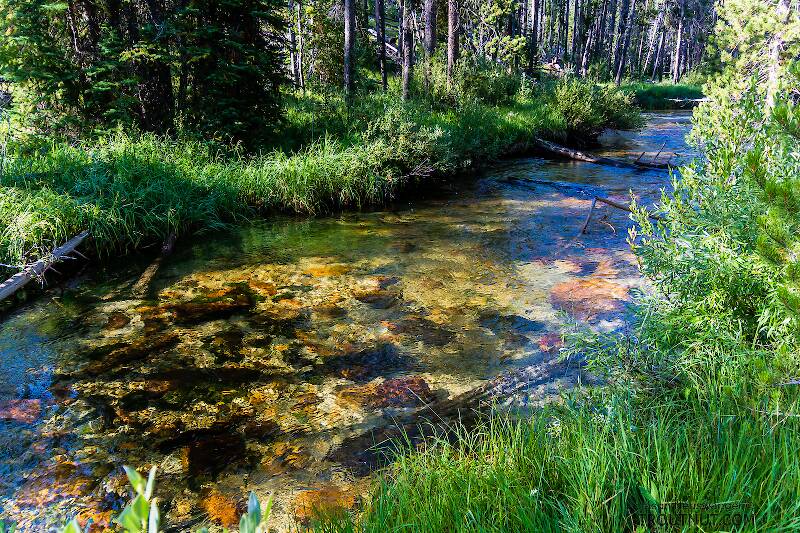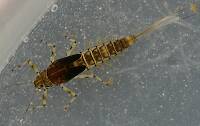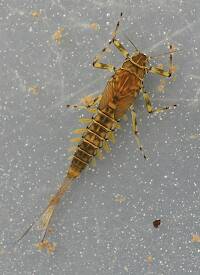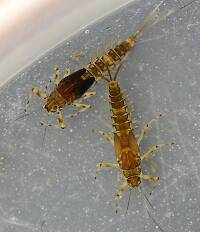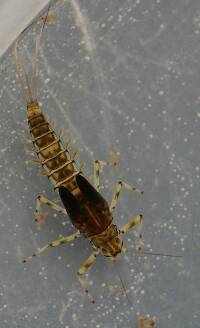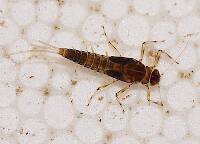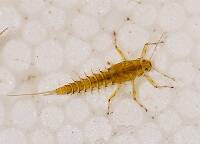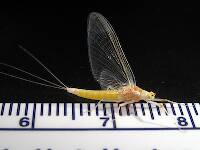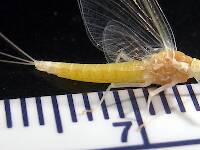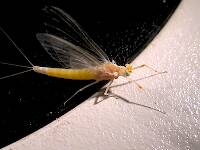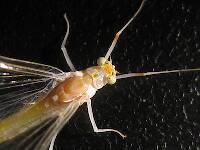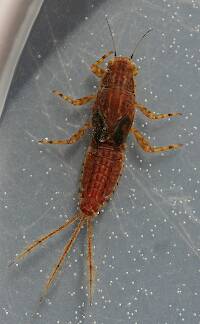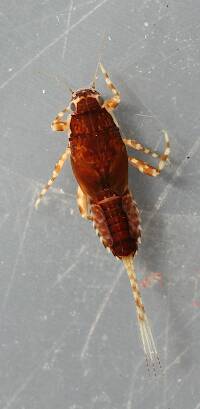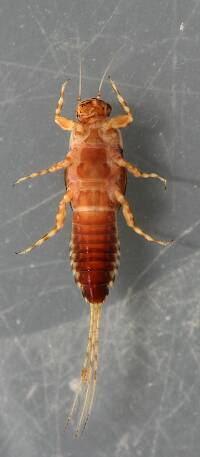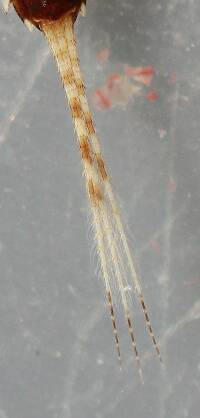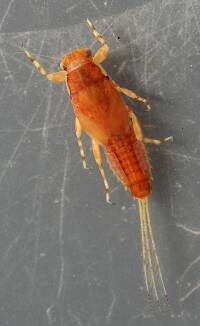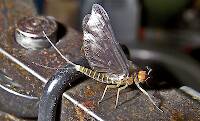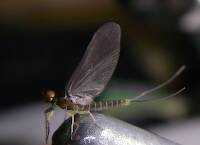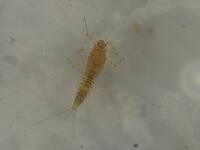
Hex Mayflies
Hexagenia limbata
The famous nocturnal Hex hatch of the Midwest (and a few other lucky locations) stirs to the surface mythically large brown trout that only touch streamers for the rest of the year.
Featured on the forum

As far as I can tell, this species has only previously been reported from one site in Oregon along the Columbia gorge. However, the key characteristics are fairly unmistakable in all except for one minor detail:
— 4 small yellow spots on frons visible in photos
— Narrow occipital spinule row curves forward (but doesn’t quite meet on stem of ecdysial suture, as it's supposed to in this species)
— Short spinules on anterior margin of front legs
— Short rposterior row of blunt spinules on abdominal tergae, rather than elongated spinules dorsally
I caught several of these mature nymphs in the fishless, tiny headwaters of a creek high in the Wenatchee Mountains.
— 4 small yellow spots on frons visible in photos
— Narrow occipital spinule row curves forward (but doesn’t quite meet on stem of ecdysial suture, as it's supposed to in this species)
— Short spinules on anterior margin of front legs
— Short rposterior row of blunt spinules on abdominal tergae, rather than elongated spinules dorsally
I caught several of these mature nymphs in the fishless, tiny headwaters of a creek high in the Wenatchee Mountains.

Troutnut is a project started in 2003 by salmonid ecologist Jason "Troutnut" Neuswanger to help anglers and
fly tyers unabashedly embrace the entomological side of the sport. Learn more about Troutnut or
support the project for an enhanced experience here.
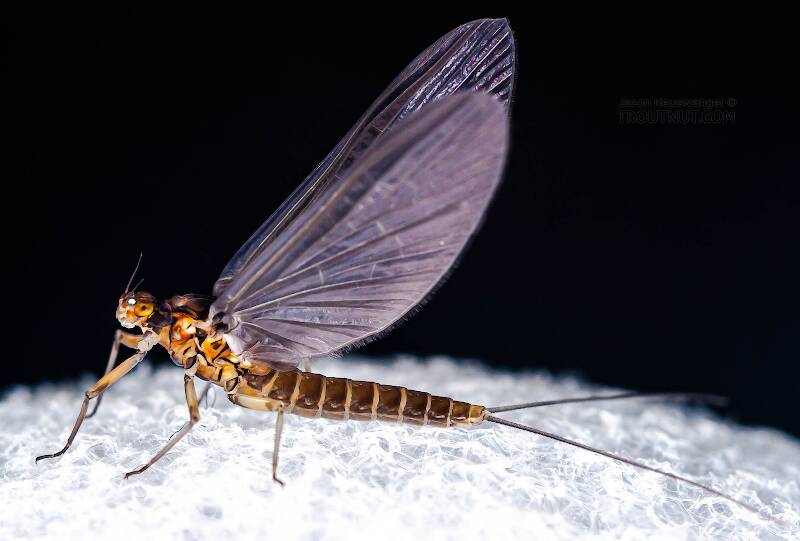
This female was associated with a male of the same species.
GONZO on Apr 4, 2007April 4th, 2007, 10:22 am EDT
Based on size, emergence timing, and general appearance, I'd guess that this and the associated male are probably B. tricaudatus.
Taxon on Apr 4, 2007April 4th, 2007, 6:33 pm EDT
Likely so, Gonzo. Based on genitalia and hind wing venation, it may be the one Dodds named Baetis moffatti prior to reclassification as B. tricaudatus. Another possibility is Pseudocloeon frondale, specifically the ones McDunnough named B. frondalis and Traver named B. australis.
GONZO on Apr 5, 2007April 5th, 2007, 5:00 am EDT
Thanks, Roger. I'm not familiar with P. frondale, but I thought Pseudocloeon lacked hind wings.
Troutnut on Apr 5, 2007April 5th, 2007, 5:07 am EDT
I'll move these to tricaudatus, then. I'm pretty sure they're not Pseudocloeon, because I keyed them to Baetis pretty confidently in Merritt & Cummins.
Jason Neuswanger, Ph.D.
Troutnut and salmonid ecologist
Troutnut and salmonid ecologist
GONZO on Apr 5, 2007April 5th, 2007, 5:53 am EDT
Yeah, first-brood tricaudatus duns are typically the earliest and largest (with females up to nearly 9mm) of the common Eastern Baetis hatches. B. brunneicolor sometimes comes close in size, but is a much later hatch.
Taxon on Apr 5, 2007April 5th, 2007, 12:23 pm EDT
I'm pretty sure they're not Pseudocloeon, because I keyed them to Baetis pretty confidently in Merritt & Cummins.
Jason-
You may well be correct. However, I would point out the Merritt & Cummins doesn't include Pseudocloeon in their keys for either mature larvae or adults.
Taxon on Apr 5, 2007April 5th, 2007, 12:59 pm EDT
I'm not familiar with P. frondale, but I thought Pseudocloeon lacked hind wings.
Gonzo-
Of the species that Needham considered Pseudocloeon at the time The Biology Of Mayflies was written, those subsequently reclassified as Acentrella, Apobaetis, Heterocloeon, and Plauditus were absent hind wings. However, four of the species he considered Baetis at that time were subsequently classified as Pseudocloeon. Specifically, they are Pseudocloeon dardanum (Baetis dardanus), P. ephippiatum (B. ephippiatus), P. frondale (B. australis & B. frondalis), P. propinquum (B. propinquus & B. spinosus), each of which have hind wings. The only other North American Pseudocloeon species are P. apache (McCafferty & Waltz), 1995, and P. longipalpus (Morihari & McCafferty), 1979, which I assume also have hind wings.
GONZO on Apr 5, 2007April 5th, 2007, 4:34 pm EDT
Thanks again, Roger. With all the revisions, I wasn't really sure where things stood. So "pseudos" without hind wings became Acentrella, Apobaetis, Heterocloeon, and Plauditus. And some Baetis with hind wings became "pseudos." I was aware of some of these revisions, but I guess I wasn't keeping track of the wing count. I know the experts have good reasons for these changes, but it sure does get confusing for laymen at times. No wonder we fall back on BWO to describe them all. ;)
Taxon on Apr 5, 2007April 5th, 2007, 7:36 pm EDT
You're certainly welcome Gonzo. I absolutely love answering questions, as I usually learn something new during the process attempting to verify my answers' accuracy.
What I learned from answering your question is that my Adult Mayfly Identification application was seriously out of date regarding Pseudocloeon hind wings, and for that, I am in your debt.
What I learned from answering your question is that my Adult Mayfly Identification application was seriously out of date regarding Pseudocloeon hind wings, and for that, I am in your debt.
GONZO on Apr 6, 2007April 6th, 2007, 5:19 am EDT
Back atcha, Roger. I had noticed some "pseudo" names on Mayfly Central and in some distribution records, but they were unfamiliar species, and the hind wing info was new to me. It did seem simpler to remember that Baetis had hind wings and Pseudocloeon did not, but I realize that scientists don't consider the convenience of anglers--nor should they.
Taxon on Apr 6, 2007April 6th, 2007, 10:59 am EDT
The N. American Baetidae genera without hind wings are Plauditus, Apobaetis, plus (those species of) Procloeon and Centroptilum once classified as Cloeon.
If anyone can either improve on this rule of thumb, or demonstrate its lack of usefulness, please speak up.
If anyone can either improve on this rule of thumb, or demonstrate its lack of usefulness, please speak up.
GONZO on Apr 6, 2007April 6th, 2007, 1:26 pm EDT
Roger-
I won't even attempt to give any definitive word on the "can of worms" we've inadvertently opened here. I'm going to wait for Konchu to pick up this thread--if he's not already chuckling at our efforts! ;)
I did, however, just finish reading the "Revision of Heterocloeon McDunnough (Ephemeroptera: Baetidae)" by McCafferty, Waltz, Webb, and Jacobus (JIS 2005; 5:35). It was a very strenuous upstream wade for me, but I'll try to share a few points.
In addition to the Baetidae genera or parts of genera you mentioned in your last post as having no hind wings, I would add some Acentrella and some Heterocloeon as well, based on my reading of this fascinating paper. It deals primarily with Heterocloeon, but much contextual reference to other genera is also found in the text. And the suggested cladistic structure that supports their revisions is particularly interesting.
They propose two new subgeneric groups within Heterocloeon--Iswaeon and Jubilatum. With regard to our hind-wing quandary, Iswaeon lack hind wings, they are present but small in Heterocloeon s.s. (sensu stricto), and either small or absent from Jubilatum. Within Iswaeon, H. anoka is revalidated (formerly considered a junior synonym of Plauditus punctiventris and, prior to that, was the old Pseudocloeon anoka that Swisher and Richards wrote about). Additionally, H. davidi is a new species and H. rubrolaterale is a new combination in the same subgenus.
The current view of the process by which hind wings, median caudal filaments, etc. become reduced was the most revealing aspect for me. They say "This is reductionist evolution that has occurred numerous times independently [my emphasis] throughout Baetidae...." This goes a long way toward explaining why some of these divisions are not as clean and simple as they once appeared to be.
I thought that you and Jason might be interested in this. But I'm also aware that others might regard this as meaningless babble. To them, I sincerely apologize. Back to fly fishing!
Best,
Lloyd
I won't even attempt to give any definitive word on the "can of worms" we've inadvertently opened here. I'm going to wait for Konchu to pick up this thread--if he's not already chuckling at our efforts! ;)
I did, however, just finish reading the "Revision of Heterocloeon McDunnough (Ephemeroptera: Baetidae)" by McCafferty, Waltz, Webb, and Jacobus (JIS 2005; 5:35). It was a very strenuous upstream wade for me, but I'll try to share a few points.
In addition to the Baetidae genera or parts of genera you mentioned in your last post as having no hind wings, I would add some Acentrella and some Heterocloeon as well, based on my reading of this fascinating paper. It deals primarily with Heterocloeon, but much contextual reference to other genera is also found in the text. And the suggested cladistic structure that supports their revisions is particularly interesting.
They propose two new subgeneric groups within Heterocloeon--Iswaeon and Jubilatum. With regard to our hind-wing quandary, Iswaeon lack hind wings, they are present but small in Heterocloeon s.s. (sensu stricto), and either small or absent from Jubilatum. Within Iswaeon, H. anoka is revalidated (formerly considered a junior synonym of Plauditus punctiventris and, prior to that, was the old Pseudocloeon anoka that Swisher and Richards wrote about). Additionally, H. davidi is a new species and H. rubrolaterale is a new combination in the same subgenus.
The current view of the process by which hind wings, median caudal filaments, etc. become reduced was the most revealing aspect for me. They say "This is reductionist evolution that has occurred numerous times independently [my emphasis] throughout Baetidae...." This goes a long way toward explaining why some of these divisions are not as clean and simple as they once appeared to be.
I thought that you and Jason might be interested in this. But I'm also aware that others might regard this as meaningless babble. To them, I sincerely apologize. Back to fly fishing!
Best,
Lloyd
Taxon on Apr 6, 2007April 6th, 2007, 2:41 pm EDT
Lloyd-
Boy, I sure hope Konchu shows up soon to save us from ourselves. However, until that happens, I'll just pitch in and help you pile the babble a bit higher.
Acentrella parluva (Pseudocloeon parvulum) and A. turbida (P. carolina and P. turbidum) as described in TBOM, have no mention of hind wings. However, the photos of P. carolina in Hatches II on Color Plate XXII clearly show hind wings. But, perhaps they were misidentified.
As far as Heterocloeon is concerned, the only species TBOM describes are H. amplum (Baetis amplus), H. curiosum, H. frivolum (B. frivolus), and H. rubrolaterale (P. rubrolaterale), only the last of which has no mention of hind wings.
Incidentally, I'd be extremely interested in reading the Revision Of Heterocloeon you referenced, as well as any other papers containing adult mayfly external morphographic descriptions supplemental to TBOM.
Boy, I sure hope Konchu shows up soon to save us from ourselves. However, until that happens, I'll just pitch in and help you pile the babble a bit higher.
Acentrella parluva (Pseudocloeon parvulum) and A. turbida (P. carolina and P. turbidum) as described in TBOM, have no mention of hind wings. However, the photos of P. carolina in Hatches II on Color Plate XXII clearly show hind wings. But, perhaps they were misidentified.
As far as Heterocloeon is concerned, the only species TBOM describes are H. amplum (Baetis amplus), H. curiosum, H. frivolum (B. frivolus), and H. rubrolaterale (P. rubrolaterale), only the last of which has no mention of hind wings.
Incidentally, I'd be extremely interested in reading the Revision Of Heterocloeon you referenced, as well as any other papers containing adult mayfly external morphographic descriptions supplemental to TBOM.
Konchu on Apr 6, 2007April 6th, 2007, 4:30 pm EDT
...bwa-hahaha...
My cold Friday night beverage and I are enjoying reading this thread. Not sure how much I can contribute, however. Y'all are doing a mighty fine job of sorting things out.
I think that the idea of characteristics with independent reduction (way to go Gonzo!) is important here with regards to the hind wing(pad)s and median filament. Reductions probably are something relatively easy to achieve evolutionarily speaking, as opposed to the spontaneous sprouting of some novel new structure. Also, less energy needed during development = more energy that can be devoted elsewhere.
Find the Heterocloeon study available FREE online at
http://www.insectscience.org/5.35/.
I'll add that I think trying to ID a female dun/spinner baetid beyond the family level is probably...well, I'd better get back to sipping my beverage before it warms up too much. Only then might I have a go at identifying female baetids. Sorry the baetids are such a mess, but I think they're starting to get better!
My cold Friday night beverage and I are enjoying reading this thread. Not sure how much I can contribute, however. Y'all are doing a mighty fine job of sorting things out.
I think that the idea of characteristics with independent reduction (way to go Gonzo!) is important here with regards to the hind wing(pad)s and median filament. Reductions probably are something relatively easy to achieve evolutionarily speaking, as opposed to the spontaneous sprouting of some novel new structure. Also, less energy needed during development = more energy that can be devoted elsewhere.
Find the Heterocloeon study available FREE online at
http://www.insectscience.org/5.35/.
I'll add that I think trying to ID a female dun/spinner baetid beyond the family level is probably...well, I'd better get back to sipping my beverage before it warms up too much. Only then might I have a go at identifying female baetids. Sorry the baetids are such a mess, but I think they're starting to get better!
Troutnut on Apr 6, 2007April 6th, 2007, 4:51 pm EDT
I'm glad these specimens provided fodder for such interesting discussion!
That's definitely true in general, but this one is associated with a male. I captured them a few minutes apart in about the same spot.
Your observation brings back memories of deep consternation I felt while trying to ID some late-summer specimens last year, which I suspect belong to all-female parthenogenetic Baetid populations. How am I supposed to ID such a thing without a DNA lab?
I'll add that I think trying to ID a female dun/spinner baetid beyond the family level is probably...well, I'd better get back to sipping my beverage before it warms up too much.
That's definitely true in general, but this one is associated with a male. I captured them a few minutes apart in about the same spot.
Your observation brings back memories of deep consternation I felt while trying to ID some late-summer specimens last year, which I suspect belong to all-female parthenogenetic Baetid populations. How am I supposed to ID such a thing without a DNA lab?
Jason Neuswanger, Ph.D.
Troutnut and salmonid ecologist
Troutnut and salmonid ecologist
Taxon on Apr 6, 2007April 6th, 2007, 5:01 pm EDT
Cover restored. Thanks for the link, Konchu.
Talk later.
Talk later.
Konchu on Apr 7, 2007April 7th, 2007, 2:50 am EDT
Even if the females were taken with a male, you've got to be careful about IDs. Several Baetis species can live together, and they can be more or less difficult to tell apart. Although, given the time of year, these probably are tricaudatus.
Some IDs are just difficult. I remember spending an entire day not too long ago sorting through old papers, looking under a microscope and pounding the table, just to come up with an ID of "B. tricaudatus." My experiences with some caddisflies are not much better.
Even with a DNA lab, IDs are tough. Based on what little I have gathered, scientists don't quite know enough about variation within most species to have an idea of what DNA differences constitute different species; its much like morphology (actually DNA is just a really small kind of morphology). Even apparently large differences in DNA sequence could be the result of a very simple event that may or may not be cause for "Speciation."
Yikes, this thread is taking a serious turn. I don't want to scare away readers, Troutnut, so I'll get back to my warm Saturday morning beverage.
PS-Thanks to those who made modifications to past posts. ;)
Some IDs are just difficult. I remember spending an entire day not too long ago sorting through old papers, looking under a microscope and pounding the table, just to come up with an ID of "B. tricaudatus." My experiences with some caddisflies are not much better.
Even with a DNA lab, IDs are tough. Based on what little I have gathered, scientists don't quite know enough about variation within most species to have an idea of what DNA differences constitute different species; its much like morphology (actually DNA is just a really small kind of morphology). Even apparently large differences in DNA sequence could be the result of a very simple event that may or may not be cause for "Speciation."
Yikes, this thread is taking a serious turn. I don't want to scare away readers, Troutnut, so I'll get back to my warm Saturday morning beverage.
PS-Thanks to those who made modifications to past posts. ;)
Konchu on Apr 7, 2007April 7th, 2007, 2:54 am EDT
"Your observation brings back memories of deep consternation I felt while trying to ID some late-summer specimens last year, which I suspect belong to all-female parthenogenetic Baetid populations."
Gotta be careful about this. In some insect species, the male and female emergences are staggered, so that the males are "ready to go" as soon as the females become "available." If you collected just one time, you might have missed the males.
Gotta be careful about this. In some insect species, the male and female emergences are staggered, so that the males are "ready to go" as soon as the females become "available." If you collected just one time, you might have missed the males.
GONZO on Apr 7, 2007April 7th, 2007, 3:31 am EDT
I just remembered that Roger and I had grappled with the Plauditus punctiventris/Heterocloeon anoka/Pseudocloeon anoka identity crisis once before--now it makes sense! And thanks to Konchu for confirming that males sometimes emerge before females. I've observed this many times (mostly by sampling populations of mature nymphs and noticing which wingpads were darkening first), but I've never read anything about it.
Thanks to all who made this thread an educational experience for me. Any opportunity to learn is a good one, and the things that provide those opportunities are often surprising.
-Lloyd
Thanks to all who made this thread an educational experience for me. Any opportunity to learn is a good one, and the things that provide those opportunities are often surprising.
-Lloyd
Troutnut on Apr 7, 2007April 7th, 2007, 6:15 am EDT
Several Baetis species can live together, and they can be more or less difficult to tell apart. Although, given the time of year, these probably are tricaudatus.
Yeah, I figured the odds of two species of such large Baetis having synchronized broods in the same spot this early in the year are next to nil.
Yikes, this thread is taking a serious turn. I don't want to scare away readers, Troutnut, so I'll get back to my warm Saturday morning beverage.
I think this thread lost any casual observers long before your post. Your audience here is me, Taxon, Gonzo, and any silent observers of a like mind who thrive on technical detail... so there's no need to hold back. :)
You've piqued my curiosity by being so non-specific about that beverage. "Warm Saturday morning beverage" takes such a long time to type compared to "coffee" or "tea" that I must wonder if you're trying to hide its identity. Have you invented a new hot drink derived from mayflies, perhaps?
Gotta be careful about this. In some insect species, the male and female emergences are staggered, so that the males are "ready to go" as soon as the females become "available." If you collected just one time, you might have missed the males.
True. I found these females on several different evenings, and never found seemingly associated males. (Although it is quite possible I just missed them.) I seem to remember my ID attempts bringing me closest to genera containing major parthenogenetic species, which is why I suspected this was the problem, but I could be wrong.
Jason Neuswanger, Ph.D.
Troutnut and salmonid ecologist
Troutnut and salmonid ecologist
Quick Reply
Related Discussions
Topic
Replies
Last Reply
1
Sep 9, 2008
by GONZO
by GONZO
6
Nov 12, 2006
by Martinlf
by Martinlf
25
Jan 8, 2016
by Wbranch
by Wbranch

